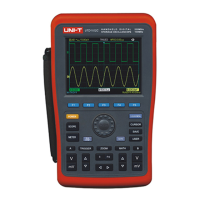
Do you have a question about the UNI-T UTD1000 Series and is the answer not in the manual?
| Channels | 2 |
|---|---|
| Power | 100-240VAC, 50/60Hz |
| Input Coupling | DC, AC, GND |
| Max Input Voltage | 400V (DC + AC Peak) |
| Timebase Range | 5 ns/div to 50 s/div |
| Trigger Types | Edge, Pulse, Video, Slope, Alternate |
| Interface | USB Device, USB Host |
| Vertical Resolution | 8 bit |
Explanation of safety terminology and symbols used in the manual.
Information regarding messages that may appear on the product.
Introduction to the front panel and its controls for easy operation.
Steps to check the unit and accessories for damage or missing items.
Procedure to perform a quick check to ensure the oscilloscope is operating correctly.
How to adjust the probe for accurate measurements.
Using the auto setup function to optimize waveform display.
Detailed explanation of the oscilloscope's front panel controls and layout.
Adjusting vertical range and position for optimal signal display.
Adjusting time base and horizontal position of the trigger point.
Setting up trigger parameters for stable waveform acquisition.
Guide to restoring the oscilloscope to factory default settings.
Explains how to use the jog dial for menu navigation and adjustments.
How to configure vertical settings like V/div and position.
How to configure horizontal settings like time base and shift.
How to configure trigger parameters for stable waveform acquisition.
Settings for screen display, data acquisition, and auto measurements.
How to save and recall waveforms and setups, and capture the screen.
Using cursors for precise voltage and time measurements.
Configuration of system utilities like battery saving and language.
How to use math functions like FFT, addition, subtraction.
Zooming into waveform details using window extension.
How to hide or display menus.
Instructions on using the RUN/STOP button and Auto Setup.
How to use the oscilloscope's built-in multimeter functions.
Steps to observe and measure basic signal characteristics like frequency.
Analyzing signal delay and waveform changes in a circuit.
Techniques for capturing single-shot events like pulses and glitches.
Methods to filter or reduce noise for clearer waveform display.
Precise measurement of voltage and time using cursors.
Analyzing phase differences between signals using X-Y mode.
How to achieve stable video output signal display using video trigger.
Explains various system prompts and messages displayed by the oscilloscope.
Step-by-step guide to diagnose and resolve common operational issues.
Procedures for updating the oscilloscope's firmware via USB.
Detailed technical specifications and performance metrics.
List of standard and optional accessories included with the oscilloscope.
Guidelines for general care, cleaning, and maintenance of the unit.